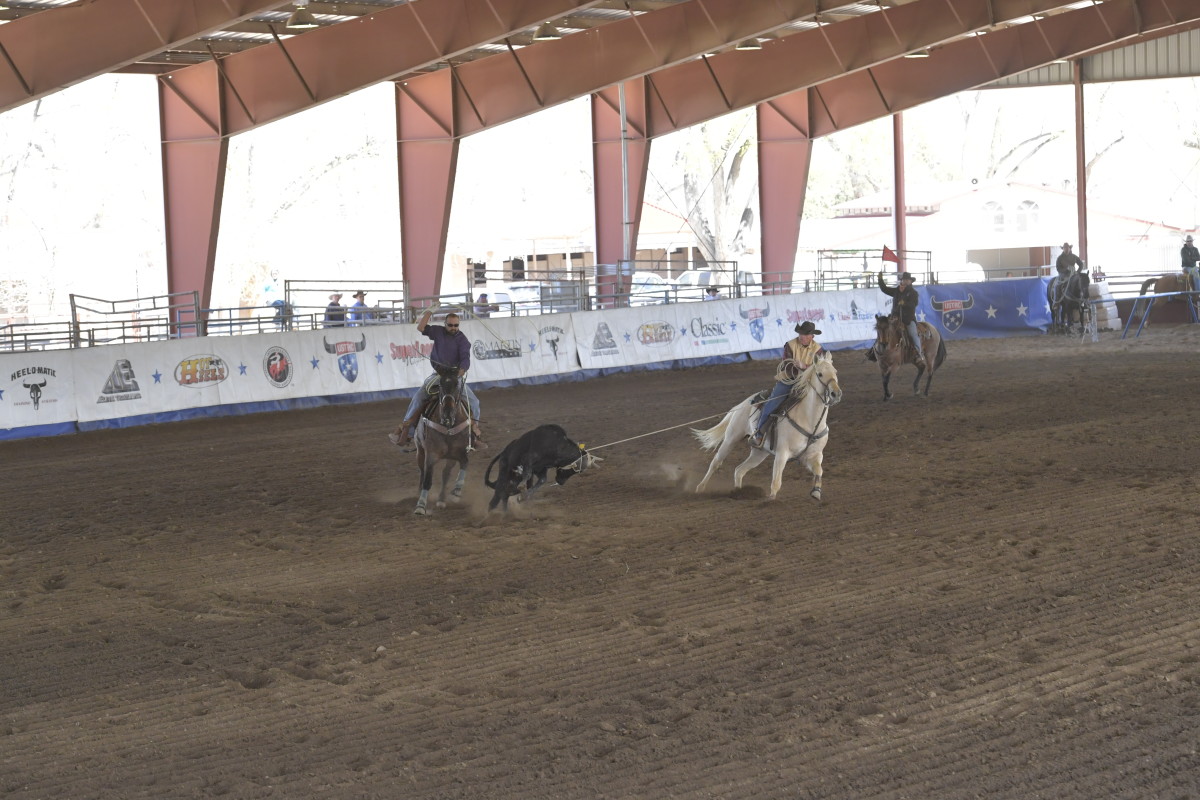Q: Where did you grow up, and what was your childhood like?
A: I was raised in the eastern part of the state in McClave, near Lamar. My dad was a farmer—we raised sorghum, alfalfa, and sugar beets and ran a few head of cattle. I grew up milking cows every morning, and separating the cream. We sold cream and eggs. That’s how we paid the grocery bill. My dad (Raymond) roped calves some, so my two brothers and two sisters and me learned to rope calves. I was small. I only weighed 100 pounds when I graduated from high school. I rode racehorses at fair meets in Colorado, Oklahoma, and Kansas. I also rode a lot of match races, which are basically side bets where someone says, “My horse can outrun your horse.” As a kid and in college, I roped calves, rode bulls and bareback horses, and a few saddle broncs. They had ribbon roping instead of team roping when I was in college. For 15 years, all I did was rope calves and ride bareback horses at the amateur rodeos.
Q: When did team roping come in?
A: After I got married—on April 19, 1958—team roping got to our country in the late ’50s and early ’60s, but it was team tying. So me and some of my friends started entering the team tying. I was fortunate to have good partners—guys like George Draper and Gus Webb—and win pretty regularly. They were good cowboys and good heelers.
Q: What was it like to rodeo with and make the NFR with your 15-year-old son?
A: It’s been a good ride. We’ve enjoyed it. I went to work for the state of Colorado as a livestock inspector in 1961, and just went to a few amateur rodeos close to home for years. I was more concerned with raising my family than going off rodeoing. Back in those days, they didn’t make pickups good enough to pull trailers very good. We pulled our two-horse trailers with cars. The Buick Electra 225s were the best, and we had two-by-55 air conditioning. We drove 55 miles an hour with two windows rolled down. When Kelly got to running barrels, our first stock trailer hauled three horses, and we pulled it behind that car.
Q: What do you consider the ultimate highlights of your rodeo career?
A: The year they put on the Presidential Rodeo in Washington D.C. (1983) was pretty special. J.D. and I were in the lead for the world at that time, and J.D. and Kelly and I were all invited back there to participate, so the whole family went. Jan got a tour of the White House by (cowboy Secretary of Commerce) Mac Baldrige’s wife, and we got to have lunch with President Reagan on the lawn at the White House. Kelly borrowed a horse, and won second in the barrel race. I borrowed a little bay horse from somebody back there, and J.D. rode a pickup horse. We got one captured and won it, and it was pretty special to get handed buckles engraved with “Presented by the President of the United States” on the back by President Reagan himself. Of course another big highlight for our family was when all three of us made the Finals in 1984.
Q: You Yateses are renowned horsemen. What are the most important basic principles of good horsemanship in your book?
A: Things have changed so much. In my time, when I was young, the horses were colder blooded. They weren’t bred like the horses we ride today, and they needed a lot of years of hard riding before they ever made good horses. The better-bred horses today kind of train themselves. They’re smarter and easier to train. Horses are so smart anymore. You have to let them progress at their own speed and not overdo it, so you don’t burn them up, and they can mature at their own pace. You’ve got to give them time. Too many people get in too big a hurry trying to finish a horse. But getting in too big a hurry gets you in trouble. I’m pretty proud of J.D., and his knowledge and ability to read and train a horse. He has an unusual gift, and it’s been good watching. Now I’m watching him get that through to Trey.

Q: Do you scratch your head over how tough team roping is today?
A: Oh yeah, it’s mind boggling. The scores have gotten shorter and the cattle have gotten smaller. But there are a lot of good ropers out there—enough of them that it’s a wicked old deal at the rodeos. It’s good watching, but it’s a tough old road, looks to me like. A lot of young guys can throw a lot of rope and be quick, but not many of them can do it twice in a row. There’s still room at the averages, like Salinas, Cheyenne, and the BFI, for the Jake Barneses and J.D. Yateses. When you set the score out there, it puts a different read on who’s going to win, and the guys with the horses to handle it are going to win. Those one-headers are a snake pit.
Q: How much do you love to rope?
A: I enjoy going out to the arena with J.D. and Trey, and watching J.D. work those young horses. I’ve gotten kind of spoiled. I don’t like to run a lot of cattle anymore. I’ll go out there and rope six or eight, then I watch the rest of them rope. I enjoy watching J.D. and Trey rope as much as I like doing it, or quite a bit more anymore. It’s been a good ride.








